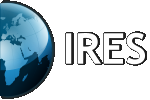



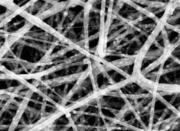






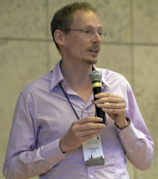
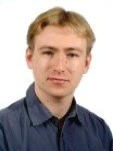
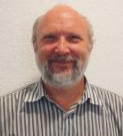
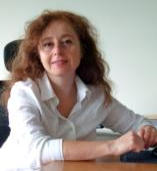







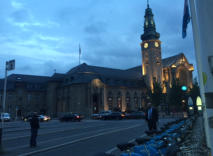






Liquid Crystalline and Responsive Fibers International Research
Experience for Students (LCRF-IRES)
Overview
In collaboration with Dr John West of Kent State University and Dr Margaret Frey of
Cornell University, Dr Antal Jákli, Professor at the Kent State Liquid Crystal Institute,
secured a research grant from the National Science Foundation to send eighteen
undergraduate and graduate students, over the course of four years, to partner
institutions in South Korea, in Luxembourg, and in Germany to engage in relevant
and current work in liquid crystal science and the production of responsive fibers and
smart textiles. Through this grant, not only did students work on cutting-edge liquid
crystal science and research, but they also gained valuable experience in working
abroad and making connections with foreign researchers and scientists.
Research experience was conducted at the following locations:
• Seoul National University Graduate School of Convergence Science in
Suwon, South Korea
(hosts: Jan Lagerwall, PhD; and Giusy Scalia, PhD)
• University of Luxembourg Physics and Materials Science Research Unit in
Luxembourg City, Luxembourg
(host: Jan Lagerwall, PhD)
• Otto-von-Guericke Universität Magdeburg in Magdeburg, Germany
(hosts: Ralf Stannarius, PhD rer nat; and Alexey Eremin, PhD rer nat)
• Max Planck Institute for Dynamics and Self Organization in Göttingen,
Germany (host: Tanya Ostapenko, PhD)
The schedule of research was as follows:
Summer 2013 (Suwon, South Korea): Electrospun responsive fibers and mats
Summer 2014 (Magdeburg, Germany, and Luxembourg City, Luxembourg):
Electrospun responsive fibers and mats and mechanically-produced free-standing
films and fibers
Summer 2015 (Magdeburg, Germany, and Luxembourg City, Luxembourg):
Electrospun responsive fibers and mats and mechanically-produced free-standing
films and fibers
Summer 2016 (Göttingen, Germany, and Luxembourg City, Luxembourg):
Electrospun encapsulated responsive structures and dynamics of confined systems
and buckling fibers
The Hosts
Antal István "Tony" Jákli
is the chief overlord and PI of the project. Educated in
Hungary at the Eötvös Loránd University in Budapest, a postdoctoral researcher
under renowned liquid crystal scientist Alfred Saupe, and a professor at the Kent
State University Liquid Crystal Institute since 2001, his interests particularly lie in the
domain of bent-core liquid crystals and their applications.
John L. West
is a Trustees Research Professor of Chemistry at Kent State University
and co-PI of this project. Having worked with polymer-dispersed liquid crystals for
over 25 years, he pioneered the development of polymer-dispersed liquid crystals,
bistable cholesteric dispersions, and stressed liquid crystal systems.
Margaret W. Frey,
Associate Professor of Fiber Science and Apparel Design at
Cornell University in Ithaca, New York, USA, is a co-PI for the grant. An alumna of
North Carolina State University’s Fiber and Polymer Science program, her interests
include the synthesis of fibers with responsive properties and their incorporation into
smart textiles.
Jan P. F. Lagerwall
is a secondary overlord of the project and a professor in the
Physics and Materials Science Research Unit at the University of Luxembourg. A
graduate of Chalmers Institute of Technology in Gothenburg, Sweden, he is a well-
known expert in the field of liquid crystal science with his areas of expertise including
liquid crystals in many flavors, microfluidics, and electrospinning.
Giusy Scalia
is an adjoint de recherche at the University of Luxembourg. She
received her doctorate from Chalmers Institute of Technology in Gothenburg,
Sweden. Her current research interests lie in composite fibers, carbon nanotubes,
graphene oxide and the phases it forms, and semiconducting liquid crystals.
Ralf Stannarius
(left) is a secondary overlord of the project, Professor, and head of
the Department for Nonlinear Phenomena at Otto-von-Guericke Universität
Magdeburg in Magdeburg, Germany. In collaboration with Assistant Professor
Alexey Eremin
(right), his group has performed significant, groundbreaking research
in ferrielectric bent-core liquid crystals. Dr Stannarius is an expert in liquid crystals
and other fluids of reduced dimensionality, while Dr Eremin's foci are on symmetry,
polarity, and chirality of ferroelectric liquid crystal materials, especially in thin films.
Tanya Ostapenko
is a postdoctoral fellow in Dr. Oliver Bäumchen’s lab at the Max
Planck Institute of Dynamics and Self-Organization (MPIDS) in Göttingen, Germany.
She obtained her doctorate in Physics from Kent State University. Her interests lie in
the dynamics of living organisms in confinement and in rupture and dynamics of
mechanically-drawn liquid crystal filaments.
Research Overview
2013: Electrospinning of Responsive Fibers (Suwon)
Participants in 2013 were:
Joseph Angelo and Lawrence Honaker (Ph.D. Students, Chemical Physics
Interdisciplinary Program, Kent State University, Kent, OH, USA)
Both Joseph and Lawrence visited Seoul National University and worked in the
laboratories of Dr Jan Lagerwall and Dr Giusy Scalia for four weeks from mid-July to
mid-August 2013.
Joseph worked with Dae Kyom Kim, Yoomee Kye, and Minsik Hwang, all Dr.
Lagerwall's students, on the electrospinning of coaxial liquid crystal fibers which
incorporate a bent-core liquid crystal core for flexoelectric properties.
Lawrence worked with Hyeran Jo, one of Dr. Scalia's students, and Minsik Hwang
and Yoomee Kye, two of Dr. Lagerwall's students, on the spinning of liquid crystal
fibers that incorporate carbon nanotubes into the sheath and on fibers which
incorporate liquid metal cores.
2014:
Mechanically Drawn Free-Standing Fibers and Films (Magdeburg)
Electrospun Responsive Fibers (Luxembourg City)
Participants in 2014 were:
Larissa Buttaro (Ph.D. Student) and Catherine Reyes (M.S. Student, Cornell
University, Ithaca, NY, USA)
Oliver Kress (M.S. Student), Colin McGinty, and Michael Varga (Ph.D. Students,
Chemical Physics Interdisciplinary Program, Kent State University, Kent, OH, USA)
Larissa and Oliver visited Otto-von-Guericke Universität Magdeburg and the
laboratories of Dr. Ralf Stannarius and Dr. Alexey Eremin from the end of June
through the end of July 2014.
Larissa worked with Kirsten Harth, one of Dr Stannarius’ students, and Dr Stannarius
himself on the formation of non-polar liquid crystal bubbles in surfactant-filled
environments of varying concentrations and studying the behaviors and dynamics of
said bubbles upon the introduction of air.
Oliver worked in Magdeburg doing things and stuff with fiber production and rupture
with Maria-Gabriela Tamba, one of Dr Eremin’s researchers, and Dr. Eremin himself.
Catherine, Colin, and Michael visited Dr. Jan Lagerwall and JungHyun Noh at the
University of Luxembourg for five weeks in June and July 2014.
Catherine studied the incorporation of liquid crystals doped with chiral azobenzene
and other dyes into coaxially-spun nylon fibers in an attempt to produce light-
responsive nylon fibers. Means of optimizing the properties of the fibers and the
incorporation of the liquid crystal cores into the polymer fibers were also studied.
Mike did things and stuff related to coaxial electrospinning of liquid crystal-containing
fibers with bent-core liquid crystals that show a ferroelectric phase.
Colin worked on the incorporation of conductive cores made from materials such as
PEDOT into fiber form.
2015:
Free-Standing Liquid Crystal Fibers (Magdeburg)
Electrospun Liquid Crystal Fibers (Luxembourg City)
Participants in 2015 were:
Greta Cukrov, Matthew Murachver, and James Honaker (Ph.D. Students, Chemical
Physics Interdisciplinary Program, Kent State University, Kent, OH, USA)
Emily Kerr (B.S. Student, Chemistry, Xavier University, Cincinnati, OH, USA)
Aditi Naik (Ph.D. Student, Polymer Science and Engineering, University of
Massachusetts Amherst, Amherst, MA, USA) Vanessa Stewart Sanchez (B.S. Student, Fiber Science,
Cornell University, Ithaca, NY, USA)
Greta, Matthew, and James conducted research in Magdeburg, Germany, in the labs
of Dr. Ralf Stannarius and Dr. Alexey Eremin for five weeks from the end of June to
the end of July 2015.
Greta worked in Dr. Ralf Stannarius' lab, under Dr. Alexey Eremin's supervision,
investigating the M37 liquid crystal material using optical polarizing microscopy,
Polscope as well as electro-optical techniques. She made free standing films and
filaments and observed the dynamics in different phases. Towards the end of her
internship, she started to make electo-optical measurements in order to find the
elastic constants of the material.
James continued the previous work of Larissa Buttaro and worked with Kirsten Harth
on the study of smectic liquid crystal bubbles, their formation, and their rupture.
Matthew studied the formation and rupture of novel fibers of liquid crystal materials,
both in the form of individual fibers and bundles, under varying thermal and
oscillatory conditions.
Emily, Aditi, and Vanessa travelled to the University of Luxembourg to the lab of Dr.
Jan Lagerwall for five weeks from mid-June to mid-July 2015.
Emily worked on testing different solvents and solvent mixtures to encase
cholesteric liquid crystals in electrospun PVP fibers. She also did some work on
encasing the cholesteric liquid crystals in other polymer sheaths. Final work focused
on encasing DCM dye with a nematic liquid crystal and chiral dopant in PVP fibers
for future lasing experiments.
Aditi’s research centered on coaxially electrospinning polymeric sheaths and liquid
crystalline cores. She examined the fiber formation and morphology of various
polymer sheaths at different spinning conditions. Additionally, she produced coaxially
electrosprayed polymeric beads filled with a cholesteric liquid crystal mixture,
causing the polymer beads to be temperature responsive and show a range of
colors in polarized light microscopy at different temperatures.
In her project, Vanessa investigated using different solvent systems in coaxial
electrospinning of nanofibers with a polymer sheath and liquid crystal core in order
to determine if the same solvent could be used for both core and sheath. She also
studied the effects of solvents on producing liquid crystal core microfibers by means
of air brush fiber production.
2016:
Dynamics of Confined Systems and Buckling Fibers (Göttingen)
Electrospun Encapsulated Responsive Structures (Luxembourg City)
Participants in 2016 were:
Michelle Park (B.A. Student, Fashion Design, Kent State University, Kent, OH, USA)
Vianna Chan (B.S. Student, Fiber Science, Cornell University, Ithaca, NY, USA)
Laura Saunders (B.S. Student, Chemistry, State University of New York at Buffalo,
Buffalo, NY, USA)
Danylo Lavrentovich (B.S. Student, Computer Science and Chemistry, University of
Chicago, Chicago, IL, USA)
Matthew Kim (B.Eng. Student, Chemical Engineering, University of Arizona, Tuscon,
AZ, USA)
Michelle, Vianna, and Laura visited the University of Luxembourg for five weeks in
June and July of 2016 and worked with Dr. Anshul Sharma and Catherine Reyes on
the electrospraying of polymer-encapsulated liquid crystal beads.
Danylo and Matthew spent five weeks in June and July of 2016 at the Max Planck
Institute in Göttingen, Germany.
Danylo worked with Dr. Tanya Ostapenko on the swimming dynamics of photo-
responsive plankton in confined environments of various geometries and
dimensions.
Matthew worked with Oliver Kress on the rupture and recoil behavoir of liquid crystal
filaments.
Successes
• After their internships during the IRES program, Oliver Kress moved to Georg-
August-Universität Göttingen in Germany and Catherine Reyes and Lawrence
Honaker to the University of Luxembourg to work on their doctorates in fields related
to the topics of their internships.
• Larissa Buttaro and James Honaker had their work with Kirsten Harth and Dr.
Stannarius published as a paper, Dynamic interface tension of a smectic liquid
crystal in anionic surfactant solutions, in Chemical Physics and Physical Chemistry
in 2015.
• Part of the work Oliver did during his internship in Magdeburg was published
as a paper, Rupture and recoil of bent-core liquid crystal filaments, in Soft Matter in
2016.
• Results from internships have led to several presentations and talks at
conferences of the International Liquid Crystal Society and the American Physical
Society.
Interested?
We are looking for highly-motivated physical sciences students interested in
participating in this program in the summer of 2016. Please read the information below if you are
interested.
Eligibility
Five to six students will be sent to Germany and to Luxembourg for about five weeks
during the summer of 2016. Tentative program dates are 19 June to 23 July 2016.
Applicants should:
· Be citizens, nationals, or lawful permanent residents of the United States of
America at the time of application (in accordance with the NSF 12-551 program overview).
· Hold a valid United States passport valid through 31 January 2017 or passport
from their country of nationality plus a current, valid Permanent Residence Card valid for the
same. You must be able to provide proof of such along with your application.
· Be a full-time student in good standing in an undergraduate or graduate physical
science discipline (Chemical Physics, Physics, Chemistry, Fiber Science, Polymer Science,
etc.) with a strong academic and research performance. Students from Kent State
University and Cornell University with a GPA of at least 3.40 are preferred, but all applicants
will be considered.
· Have an interest in performing research abroad and an open mind to different
cultures.
· Not have already participated in the LCRF-IRES program.
Women, minorities, those with disabilities, and those with minimal or nonexistent
international travel experience are especially encouraged to apply.
Students will need to submit current transcripts; letters of recommendation from
laboratory research supervisors; a written statement of career objectives, interest in
participation in international research, and how participation in the program will
further their goals; and a copy of the data page of the applicant’s passport or proof of
application for a passport. Candidats will be interviewed in-person by the PI.
For your convenience, an application checklist can be found here.
Students should also be willing to write a report on the results acquired from the
undertaken research and to attend both a preliminary meeting in May 2016 and a
symposium on the research performed.
–
Logistics
Accommodations and Transportation
The host institutions will arrange affordably-priced accommodation, normally in
hostels or guest houses; this will be paid for through funding from the grant. Plane flights will
be organized and purchased by the primary investigator. Students will receive an
additional per diem allowance for the duration of their stay to cover meals, transportation,
souvenirs, essentials, and entertainment expenses in country. As most of Europe
and South Korea are serviced by extremely well-built and efficient public transportation
networks, local travel needs will be satisfied by public transportation in various forms (trains,
buses, subways, etc.); this further provides opportunities to be immersed in local life and
culture.
The host institutions have committed to ensuring the comfort of the students and to
provide significant opportunities for cultural experiences and enrichment. As such,
they may provide both local transportation and opportunities for excursions.
Students travelling to Germany are encouraged, before departure, to purchase
either a German Rail Pass (for travel solely within Germany, except to limited stations in
Switzerland and Austria) or a Eurail Pass (for travel to multiple neighboring
countries) to facilitate travel during any off-time. Students travelling to Luxembourg are likewise
encouraged to purchase a Eurail Pass for travel to neighboring countries.
Visas and Documentation
Germany and Luxembourg are member states of the Schengen Area. United States
citizens and nationals are visa-exempt for travel to the Schengen Area for a stay not longer
than 90 days in a 180-day period from the date of first entry to any Schengen state. For
travel to South Korea, a visa is not required for US citizens for tourist or business stays
(including nonrenumerated research stays) not exceeding 90 days per visit. Travellers availing
of a visa exemption, however, should have proof of sufficient finances without recourse
to employment or public funds in the destination country and health insurance for the
duration of their stay to present to immigration officers at the port of entry.
Legal permanent residents of the US, however, may not necessarily be visa-exempt
and are strongly encouraged to contact the consulate of the destination country to
find out about visa requirements. It is each participant's responsibility to ensure that they
satisfy all entry requirements, documentary and otherwise, for the destination countries and
any countries transited en route to and from the destination.
Travel insurance will be provided from the grant funds, but participants are also
strongly encouraged to have their own supplemental health insurance.
Language
Knowledge of a foreign language spoken in the destination country (i.e. German,
French, and/or Korean) is not required due to the widespread use of English in the
laboratories and in signage, but is a significant asset in day-to-day living and communication.
Kent State University offers language courses for students who are interested, and
additional linguistic support can be provided from Germanophone, Francophone, and Korean
faculty and students at the LCI.
Contact Us
For further information or to submit supplemental information for the application, please
contact:
Dr Antal I. Jákli, Principal Investigator
Kent State University Liquid Crystal Institute
PO Box 5190
Kent, OH 44242-0001
United States of America
Phone: +1 330 672 4886
Fax: +1 330 672 2796
E-mail: ajakli@kent.edu
Outreach
Featured Videos
WKYC New Channel Interview
Invited Talk at The Waterloo Institute for Nanotechnology



















